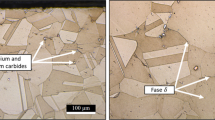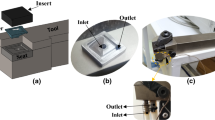Abstract
Due to the increase in environmental degradation, industries are forced to work with less harmful manufacturing means. In machining, it is known that one of the best ways to preserve cutting tool life is by using cutting fluids. However, even if this component proves to be effective, its use is still questionable because it strongly contributes to environmental degradation. For many years, several researchers have been looking for new ways to minimize this problem or even eliminate the use of cutting fluids, including the application of coatings in the cutting tool, more ecological coolants or alternative cooling methods. This work presents a thermal study of a proposed cooling technique for machining based on a cutting tool and tool holders designed with internal cooling channels, where a fluid circulates in a closed cycle called internally cooled tool (ICT). It studies the effect that the ICT technique has on the machining temperatures. This proposal can be considered ecologically less harmful because it saves the use of cutting fluids. To investigate the behavior of the system, gray iron was machined using the ICT made of cemented carbide. The response variable was the temperatures generated during cutting, measured by the tool-workpiece thermocouple system and welded thermocouple methods. Input parameters were the cutting speed and machining atmosphere conditions (dry, ICT using water at room temperature and ICT using chilled water). The ICTs reduced up to 21.52% of the temperature at the chip-tool interface compared to the dry machining process and showed a significant impact on the thermal gradients in the cutting tool and tool holder.















Similar content being viewed by others
Data availability
The datasets obtained during the current work are available from the corresponding author upon request.
Abbreviations
- CF:
-
Cutting fluids
- CO2 :
-
Carbon dioxide
- DOE:
-
Design of experiment
- e.m.f.:
-
Electromotive force
- ICT:
-
Internally cooled tools
- LN2 :
-
Liquid nitrogen
- MQL:
-
Minimum quantity of lubricant
- PHE:
-
Primary heat exchanger
- REDM:
-
Rotating electrical discharge machining
- SHE:
-
Secondary heat exchanger
References
Tay AAO (1993) A review of methods of calculating machining temperature. J Mater Process Technol 36:225–257. https://doi.org/10.1016/0924-0136(93)90033-3
Trent EM, Wright PK (2000) Metal Cutting, Butterworths, London, 4th ed
Elsheikh AH, Shanmugan S, Muthuramalingam T et al (2021) A comprehensive review on residual stresses in turning. Adv Manuf. https://doi.org/10.1007/s40436-021-00371-0
De Bartolomeis A, Newman ST, Jawahir IS et al (2021) Future research directions in the machining of Inconel 718. J Mater Process Technol 297:117260. https://doi.org/10.1016/j.jmatprotec.2021.117260
Shokrani A, Dhokia V, Newman ST (2012) Environmentally conscious machining of difficult-to-machine materials with regard to cutting fluids. Int J Mach Tools Manuf 57:83–101. https://doi.org/10.1016/j.ijmachtools.2012.02.002
Debnath S, Reddy MM, Yi QS (2014) Environmental friendly cutting fluids and cooling techniques in machining: a review. J Clean Prod 83:33–47. https://doi.org/10.1016/j.jclepro.2014.07.071
Said Z, Gupta M, Hegab H et al (2019) A comprehensive review on minimum quantity lubrication (MQL) in machining processes using nano-cutting fluids. Int J Adv Manuf Technol 105:2057–2086. https://doi.org/10.1007/s00170-019-04382-x
Benedicto E, Carou D, Rubio EM (2017) Technical, economic and environmental review of the lubrication/cooling systems used in machining processes. Procedia Eng 184:99–116. https://doi.org/10.1016/j.proeng.2017.04.075
Meyers PG (1964) Tool cooling apparatus, United States Patent Ofice, US3137184A, 541 Burnside Ave., East Hartford 8, Conn. Fied July 5,1961, Ser. No.121,9677 Caims, (CL. 77-55)
Jeffries NP, Zerkle RD (1970) Thermal analysis of an internally-cooled metal-cutting tool. Int J Mach Tool Des Res 10:381–399. https://doi.org/10.1016/0020-7357(70)90019-3
Rozzi JC, Sanders JK, Chen W (2011) The experimental and theoretical evaluation of an indirect cooling system for machining. J Heat Transfer 133:1–10. https://doi.org/10.1115/1.4002446
Ahmed MI, Ismail AF, Abakr YA, Amin AKMN (2007) Effectiveness of cryogenic machining with modified tool holder. J Mater Process Technol 185:91–96. https://doi.org/10.1016/j.jmatprotec.2006.03.123
Li T, Wu T, Ding X et al (2018) Experimental study on the performance of an internal cooled turning tool with topological channel. Int J Adv Manuf Technol 98:479–485. https://doi.org/10.1007/s00170-018-2278-1
Dhananchezian M, Pradeep Kumar M (2011) Cryogenic turning of the Ti-6Al-4V alloy with modified cutting tool inserts. Cryogenics (Guildf) 51:34–40. https://doi.org/10.1016/j.cryogenics.2010.10.011
Ingraci Neto RR, Scalon VL, Fiocchi AA, Sanchez LEA (2016) Indirect cooling of the cutting tool with a pumped two-phase system in turning of AISI 1045 steel. Int J Adv Manuf Technol 87:2485–2495. https://doi.org/10.1007/s00170-016-8620-6
TallisBazon V, MeloQueiroz Barbosa L, Chagas Rodrigues de Souza F et al (2021) Univariate cutting forces analysis of a novel internally cooled tool during cast gray iron turning. Proc 26th Int Congr Mech Eng. https://doi.org/10.26678/ABCM.COBEM2021.COB2021-2222
Peixoto A (2021) Análise da força de corte e rugosidade no torneamento de ferro fundido cinzento utilizando sistema de resfriamento interno da ferramenta. (Analysis of cutting force and roughness in gray cast iron turning using internal tool cooling system), Master dissertation. Universidade Federal de Uberlândia. https://doi.org/10.14393/ufu.di.2021.5592
Barbosa LMQ (2021) Torneamento de aço endurecido ABNT - D6 com ferramenta de PCBN refrigerada através de galerias internas (Turning of ABNT D6 hardened steel with cooled PCBN tool through internal galleries), Master dissertation. Universidade Federal de Uberlândia. https://doi.org/10.14393/ufu.di.2021.282
de Sousa JAG, Sales WF, Machado AR (2018) A review on the machining of cast irons. Int J Adv Manuf Technol 94:4073–4092. https://doi.org/10.1007/s00170-017-1140-1
Stephenson DA (1993) Tool-work thermocouple temperature measurements—theory and implementation issues. J Manuf Sci Eng Trans ASME 115:432–437. https://doi.org/10.1115/1.2901786
Machado AR, Abrão AM, Coelho RT, Silva MB Da (2015) Teoria da Usinagem dos Materiais, 3rd ed, Editora Edgard Blucher, São Paulo - SP, p 407
Kaminise AK (2012) Estudo Da Influência do Material do Porta-Ferramenta sobre Temperaturas de Usinagem no Torneamento (Study of the influence of the material of the tool holder on the cutting temperarture in turning process).Doctorate thesis, Universidade Federal de Uberlândia. https://doi.org/10.14393/ufu.te.2012.105
Tupy (2020) Perfis fundidos ®. http://www.tupy.com.br/imagens/promocional/Catalogo_Tecnico_Fuco-Portugues.pdf. Accessed 30 June 2021
Favaretto VA (2017) Desenvolvimento de um medidor de temperatura em usinagem pelo método do termopar ferramenta peça (Development of a temperature measuring system in machining based on the tool-workpiece thermocouple technique). Pontifícia Universidade Católica do Paraná, Curitiba/PR, Sci. beginners
de Lima Jr ED (2020) Medição da Temperatura de Corte no Torneamento do Aço-Ferramenta AISI D6 Temperado e Revenido Auxiliado por LN2 (Measurement of the cutting temperature in the hard turning of AISI D6 steel assisted by LN2). Master Dissertation, Universidade Federal do Rio Grande do Norte. https://repositorio.ufrn.br/jspui/handle/123456789/28897
Kaminise AK, Guimarães G, Da Silva MB (2014) Development of a tool-work thermocouple calibration system with physical compensation to study the influence of tool-holder material on cutting temperature in machining. Int J Adv Manuf Technol 73:735–747. https://doi.org/10.1007/s00170-014-5898-0
Kelly J, Cotterell M (2002) Minimal lubrication machining of aluminium alloys. J Mater Process Technol 120:327–334. https://doi.org/10.1016/S0924-0136(01)01126-8
Yigit R, Celik E, Findik F, Koksal S (2008) Effect of cutting speed on the performance of coated and uncoated cutting tools in turning nodular cast iron. J Mater Process Technol 204:80–88. https://doi.org/10.1016/j.jmatprotec.2007.10.082
Acknowledgements
The authors are grateful to Tupy S.A. for providing the work material, to Walter Tools for donating the tools, and to Nipo-Tec Ferramentas Industriais for designing and machining the channels of the ICTs inserts by REDM.
Funding
This study was funded by the Brazilian research agencies CNPq, FAPEMIG, and Coordenação de Aperfeiçoamento de Pessoal de Nível Superior—Brasil (CAPES)—Finance Code 001.
Author information
Authors and Affiliations
Corresponding author
Ethics declarations
Ethics approval
This article requires informed consent of the authors, it does not have any disclosure of potential conflicts of interest and does not involve human and/or animal participants.
Consent to participate
The authors declare that they consent to participate in this paper.
Consent for publication
The authors declare that they consent to publish this paper.
Competing interests
The authors declare no competing interests.
Additional information
Publisher's note
Springer Nature remains neutral with regard to jurisdictional claims in published maps and institutional affiliations.
Rights and permissions
Springer Nature or its licensor (e.g. a society or other partner) holds exclusive rights to this article under a publishing agreement with the author(s) or other rightsholder(s); author self-archiving of the accepted manuscript version of this article is solely governed by the terms of such publishing agreement and applicable law.
About this article
Cite this article
França, P.H.P., Barbosa, L.M.Q., Fernandes, G.H.N. et al. Thermal analysis of a proposed internally cooled machining tool system. Int J Adv Manuf Technol 124, 2807–2821 (2023). https://doi.org/10.1007/s00170-022-10602-8
Received:
Accepted:
Published:
Issue Date:
DOI: https://doi.org/10.1007/s00170-022-10602-8




